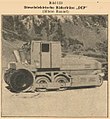Diesel-electric wheel milling machine
The diesel-electric wheel milling machine , also known as DEP for short, was a German snow clearing machine for winter service , which was first used in 1939 and then continuously developed until 1944.
Original idea and area of application
The origin of the first snow clearing machines goes back to the so-called "Peter milling machines", the inventor of which was the Swiss Peter Rocco . The snow throwers he made were then further developed by German companies. The main use of the DEP took place mainly in the winter road service of the Reichsautobahnmeistereien, but also in the municipal snow removal of Reichs and country roads (road maintenance authorities). From the winter of 1941 onwards, they were also used selectively in the rear operational area of the Eastern Front.
Mode of operation and technical data
The DEP had four drive wheels with double tires and was driven by a diesel engine with 121 kW (165 hp), which acted on the milling drum via a gearbox . The actual advance was carried out with an electrical power transmission. The milling drum was 2.50 m wide with a diameter of 1.20 m. Their maximum speed was 280 revolutions per minute. This enabled the DEP 41 to drive up layers of snow up to 25 cm in height. Higher layers of snow were initially reduced to the working height of the DEP by caterpillars. In contrast to its almost identical petrol-powered series, the diesel variant had received an improvement. The chimneys for the snow masses were no longer installed vertically, but instead curved and kept longer. The DEP thus had a dead weight of about 13 tons and reached a cruising speed of about 20 km / h on the road, where it was lower in the terrain.
Subspecies "DER"
The diesel-electric caterpillar milling machine, DER for short, was a substructure of the DEP, but in contrast to this, it was provided with a caterpillar drive. In this way, the DER could “climb” the snow, whereas the wheel milling machine had to stay on solid ground. Otherwise it had the same performance and modification as the DEP.
See also
- Petrol-electric wheel milling machine (BEP and BER)
Individual evidence
- ↑ Internal service instructions of the General Inspector for German Roads for the Road Winter Service, 1942 edition, pages 173, 174





